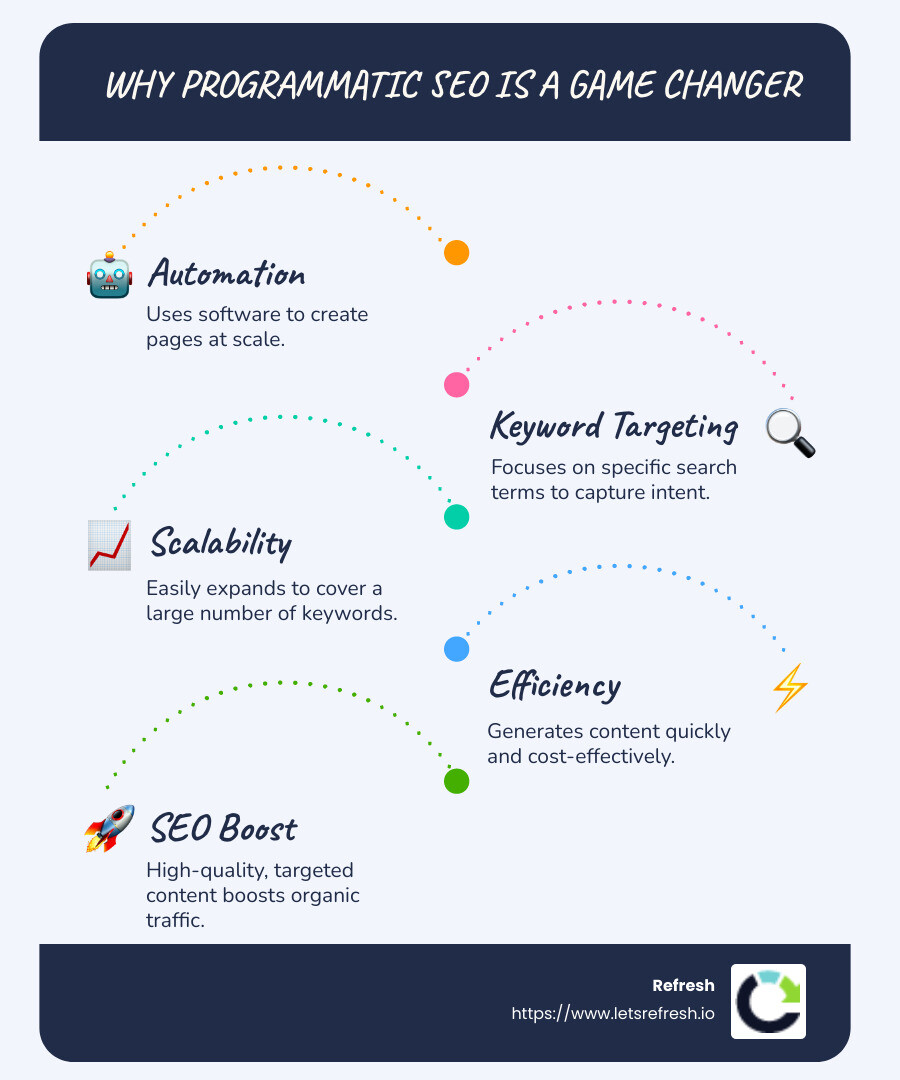July 24, 2025
Why Programmatic SEO Is a Game Changer
If you’re wondering how does programmatic seo work, let's dive right in! In simple terms, it uses automation and data to create and optimize a large number of web pages targeting specific keywords and user intents. This helps businesses boost their online presence and revenue significantly.
Quick Answer:
- Automation: Uses software to create pages.
- Keyword Targeting: Focuses on specific search terms.
- Scalability: Can easily expand to create many pages.
- Efficiency: Generates content faster and at a lower cost.
Benefits of Programmatic SEO:
- Scale: You can cover a lot of keywords and create a massive topical cluster for your website.
- Cost-Effective: Create content at a fraction of the cost of traditional methods.
- User Satisfaction: Tailors content to meet users' specific search intents, making them happy.
- SEO Boost: High-quality, targeted content improves SEO and drives organic traffic.
My name is Alexander Palmiere, and as the Founder and CEO of Refresh, I have helped numerous businesses understand how does programmatic seo work to boost their online presence. With my experience developing and launching over 200 websites, I am committed to helping you steer the intricacies of programmatic SEO.

Now, let’s get into the nitty-gritty of what is programmatic seo and how you can leverage it for your business.
What is Programmatic SEO?
Programmatic SEO is a strategy that leverages automation and technology to create and optimize a large number of web pages at scale. The goal is to target a variety of keywords and user intents to improve a website's visibility and drive organic traffic.
Automation and Technology
Automation is at the heart of programmatic SEO. Instead of manually creating each web page, businesses use software to generate hundreds or even thousands of pages quickly. This is done using:
- Templates: Standardized layouts and designs that can be reused across multiple pages.
- Databases: Collections of data that can be used to populate these templates with unique content.
- Automation Tools: Software like Airtable, Webflow, and Whalesync that streamline the creation and management of these pages.
For example, WorkbookPDF uses AI to generate language workbooks. They created dynamic pages for each language, level, and topic, allowing them to rank better on Google for long-tail keywords like "Korean workbooks for grade 11" or "German workbooks about animals."
Keyword Targeting
Programmatic SEO focuses on keyword targeting to capture search traffic from niche areas. This involves:
- Long-Tail Keywords: These are specific, less competitive keywords that are easier to rank for. For example, "CSS UI gradients for designers" is a long-tail keyword targeted by GradientPage.
- Search Intent: Understanding what users are looking for—whether it's informational, commercial, or transactional—and creating content that meets those needs.
Scalability
One of the biggest advantages of programmatic SEO is its scalability. Businesses can create a massive number of pages without a proportional increase in time or cost. This allows them to cover a wide range of keywords and topics, significantly boosting their online presence.
For instance, a company might have thousands of pages dedicated to different app integrations. Each page targets a specific keyword, like "Google Sheets and Trello integration," capturing users who are ready to solve a specific problem.
Real-World Examples
Several companies have successfully implemented programmatic SEO:
- A travel website: Uses programmatic SEO to create pages for every possible travel query.
- A local business directory: Generates pages for countless local businesses and services.
- A real estate platform: Covers every imaginable real estate query with programmatic pages.
These examples show how programmatic SEO can help businesses achieve significant growth in organic traffic by efficiently targeting a broad array of keywords.

In summary, programmatic SEO combines automation, technology, and keyword targeting to create scalable, high-quality content that meets user search intents. This strategy can help businesses grow their online presence and drive more organic traffic efficiently.
Next, we'll dive into the detailed steps of how to implement a successful programmatic SEO strategy.
How Does Programmatic SEO Work?
Programmatic SEO leverages automation and technology to efficiently create and optimize a multitude of web pages. This section will break down how it works and provide real-world examples.
The Programmatic SEO Process
Templates and databases are the backbone of programmatic SEO. Here's a simplified look at the process:
- Templates: These are standardized page layouts that ensure consistency in design and structure. They make it easy to produce numerous pages quickly.
- Databases: Collections of data that populate these templates with unique content. This data can include anything from user-generated content to business information.
- Automation Tools: Software like Airtable, Webflow, and Whalesync help streamline the creation and management of these pages.
Keyword Research
The foundation of programmatic SEO is thorough keyword research. This involves identifying:
- Head Terms: Broad keywords that define the general topic.
- Modifiers: Specific terms that narrow down the focus, making it easier to target niche queries.
For example, in the case of Zapier, the head term might be "integration," and the modifiers could be "Google Sheets" and "Trello." This results in specific keywords like "Google Sheets and Trello integration."
Long-Tail Keywords
Long-tail keywords are crucial. These are specific, less competitive search terms that are easier to rank for. For instance, GradientPage targets long-tail keywords like "CSS UI gradients for designers," making it more likely to capture niche search traffic.
Search Intent
Understanding search intent is vital. This means knowing whether users are looking for information, ready to make a purchase, or seeking a specific service. Your content should meet these needs to rank effectively.
Examples of Programmatic SEO
Several companies have successfully implemented programmatic SEO. Here are some notable examples:
- Tripadvisor: Creates pages for every possible travel query, from "best hotels in Paris" to "top restaurants in New York."
- Yelp: Generates pages for countless local businesses and services, such as "plumbers in Chicago" or "best coffee shops in San Francisco."
- Zillow: Covers every imaginable real estate query with programmatic pages, like "homes for sale in Miami" or "apartments for rent in Los Angeles."
- WorkbookPDF: Uses AI to generate language workbooks, creating dynamic pages for each language, level, and topic. For example, "Korean workbooks for grade 11" or "German workbooks about animals."
- GradientPage: Offers gradient wallpapers for designers, creating over 500 pages of CSS UI gradients, each linking to a color and a hex code.
- OG Image Gallery: Uses programmatic SEO to create pages for various image categories, targeting keywords like "best OG images for blogs."
- Peliqan: Creates pages for different software tools and integrations, targeting specific keywords like "best CRM software for small businesses."
These examples illustrate how programmatic SEO can help businesses achieve significant growth in organic traffic by efficiently targeting a broad array of keywords.
Next, we'll dive into the detailed steps of how to implement a successful programmatic SEO strategy.
Benefits of Programmatic SEO
Implementing programmatic SEO can offer several key benefits for your business. Let's explore how it can improve scalability, save costs, deliver faster results, and boost organic traffic growth.
Scalability
One of the most significant advantages of programmatic SEO is its ability to scale content creation. Unlike traditional SEO, where each page is crafted individually, programmatic SEO allows you to generate hundreds or even thousands of pages using templates and databases.
For example, companies have created thousands of pages for every app integration they support. This approach helps them reach users with specific needs, like integrating "Google Sheets with Notion," efficiently and at scale.
Cost Savings
Creating content manually can be expensive and time-consuming. Programmatic SEO, on the other hand, leverages automation tools to produce content at a fraction of the cost.
With the right tools, such as Airtable and Webflow, you can automate the process of populating templates with unique data. This means you can create 100x to 1000x more content without a proportional increase in costs.
Faster Results
Because programmatic SEO automates much of the content creation process, you can see results more quickly. Instead of waiting months to build out a content library, you can have a large number of pages up and running in weeks.
For instance, companies have been able to create over 500 pages of CSS UI gradients rapidly, allowing them to capture search traffic almost immediately. This speed can be crucial for staying ahead of competitors.
Organic Traffic Growth
By targeting a wide array of long-tail keywords and specific search intents, programmatic SEO can significantly boost your organic traffic. Long-tail keywords are less competitive but highly specific, making it easier to rank for them.
Companies create pages for countless niche queries like "best hotels in Paris" or "plumbers in Chicago," attracting a broad audience and driving substantial organic traffic.
Next, we'll dive into the detailed steps of how to implement a successful programmatic SEO strategy.
How to Implement Programmatic SEO
Step-by-Step Guide
Implementing programmatic SEO might sound complex, but breaking it down into steps makes it manageable. Here's a simple guide to get you started.
1. Keyword Research
Keyword research is the foundation of any SEO strategy. For programmatic SEO, you need to find head terms and modifiers.
- Head terms are broad keywords that represent your main topic, like "integration" for Zapier.
- Modifiers are additional words that make the head terms more specific, like "Google Sheets" or "Slack."
Use tools like Google Trends and keyword research tools to identify these terms. Look for keywords with decent search volume but low competition.
2. Research Your Niche and Competitors
Understanding your niche and competitors helps you identify opportunities. Analyze what your competitors are doing:
- What keywords are they targeting?
- What types of content are they creating?
This research can guide your own strategy and help you find untapped keywords.
3. Combine Head Terms and Modifiers
Merge your head terms with modifiers to generate a list of specific keywords. For example:
- "Google Sheets + Trello Integration"
- "Google Sheets + Slack Integration"
This step will give you a comprehensive list of keywords to target.
4. Build Your Database
Next, you need to organize your keywords and content. Airtable is a great tool for this. Create a database where each row represents a unique page, and each column contains different elements of the page, like the title, URL, and meta description.
5. Design Landing Page Templates
Create a template for your landing pages. The template should include:
- Headings
- Images
- Content sections
Tools like Webflow allow you to design these templates without coding. Make sure the template is flexible enough to accommodate different data points.
6. Collect Data
Gather the data you'll need to populate your pages. This can include:
- User-generated content
- Scraped data
- Manually collected data
Ensure your data is unique and valuable to avoid thin content penalties from Google.
7. Create Landing Pages
Use your database to generate landing pages automatically. Tools like Whalesync can connect Airtable with Webflow, allowing you to populate your templates with data from your database seamlessly.
Tools for Programmatic SEO
Several tools can make the implementation of programmatic SEO easier:
- Airtable: Excellent for organizing your database of keywords and content.
- Webflow: Ideal for designing and hosting your landing pages.
- Whalesync: Synchronizes your Airtable data with Webflow, automating the content population process.
- SEO Writing Assistant: Helps ensure your content is SEO-friendly and original.
These tools simplify the process and reduce the need for extensive coding knowledge.
By following these steps and leveraging the right tools, you can implement a successful programmatic SEO strategy that scales efficiently and drives significant organic traffic.
Implementing programmatic SEO effectively requires adhering to best practices to ensure your pages are valuable, user-friendly, and well-optimized. Here are some key strategies to follow:
Unique Content
Creating unique and valuable content is crucial. Google penalizes thin content and duplicate pages, so each page must offer something new and useful.
- Dynamic Data: Use user-generated content or business data to make each page unique.
- Custom Information: Customize content to match specific keywords and user intent.
For example, WorkbookPDF uses AI to generate personalized language workbooks, ensuring each page is unique and custom to the user's needs.
User Experience (UX)
A great user experience keeps visitors on your site longer and reduces bounce rates. Here’s how to optimize UX:
- Fast Loading Times: Ensure your pages load quickly. Tools like Webflow can help optimize your site's performance.
- Clean Layout: Use a consistent and clean layout across all pages. This makes it easier for users to steer and find information.
- Responsive Design: Make sure your site is mobile-friendly. A significant portion of web traffic comes from mobile devices.
For instance, review pages that load quickly and have a consistent layout provide a seamless user experience.
Internal Linking
Internal links are essential for distributing link juice and enhancing user navigation. Here’s how to do it right:
- Link from High Authority Pages: Link to your programmatic SEO pages from high-authority pages on your site to pass on link equity.
- Contextual Links: Use relevant anchor text that naturally fits into the content.
- Interlink Related Pages: Since programmatic SEO pages are usually related, interlink them to improve user navigation and SEO.
For example, linking to related landing pages effectively distributes link juice.
Avoid Doorway Pages
Doorway pages are low-quality pages created solely to rank for specific keywords. Google penalizes these pages, so avoid them by ensuring your pages offer real value.
- High-Quality Content: Provide comprehensive and useful information on each page.
- User Intent: Ensure the content meets the user's search intent.
- Avoid Automation Overuse: While automation is key in programmatic SEO, avoid over-relying on it for content generation. Human oversight is crucial to maintain quality.
Google’s guidelines on doorway pages emphasize the importance of creating valuable and unique content to avoid penalties.
By following these best practices, you can ensure your programmatic SEO strategy is effective and sustainable, leading to better search rankings and user satisfaction.
Frequently Asked Questions about Programmatic SEO
What is the programmatic SEO process?
The programmatic SEO process involves creating numerous landing pages quickly and efficiently to target specific keywords and rank higher on search engine results pages (SERPs). Here's a breakdown of the process:
- Automation: Use automation tools to generate multiple pages from a single template. This is key to scaling your content quickly.
- Keyword Research: Identify low-competition, high-intent keywords that are likely to convert. Tools like Google Trends and keyword research tools can help.
- Content Optimization: Ensure each page is optimized with unique metadata, headings, and relevant keywords to avoid duplicate content issues.
- Link-Building: Build backlinks to your landing pages to increase their authority and improve rankings.
How to set up programmatic SEO?
Setting up programmatic SEO involves several steps to ensure your pages are optimized and valuable:
- Keyword Research: Start by identifying head terms and modifiers. For example, if your head term is "hotel," modifiers could be "in New York," "with pool," etc.
- Head Terms and Modifiers: Combine head terms with modifiers to create a comprehensive list of keywords. This helps in targeting long-tail keywords that are less competitive but highly specific.
- Landing Pages: Create a landing page template that includes all necessary elements like images, reviews, and pricing. Use this template to generate multiple pages targeting different keywords.
- Data Collection: Gather data to populate your landing pages. This could be user-generated content, business data, or dynamically generated content.
Is programmatic SEO better than regular SEO?
Both programmatic SEO and traditional SEO have their merits, but they serve different purposes and can complement each other:
- Long-Tail Keywords: Programmatic SEO excels at targeting long-tail keywords, which are often less competitive and easier to rank for.
- Traditional SEO: This focuses on high-quality, unique content and can target more competitive keywords, helping to build brand authority.
- Brand Authority: Regular SEO helps establish your brand as an authority by providing detailed, valuable content. Programmatic SEO can drive more traffic by covering a broader range of keywords quickly.
A balanced approach that leverages both strategies can yield the best results. Use programmatic SEO to cover a wide array of keywords and traditional SEO to build depth and authority in your content.
By understanding these aspects, you can effectively implement and benefit from programmatic SEO, driving more organic traffic and achieving better search rankings.
Conclusion
At Refresh, we understand that SEO isn't just a tactic; it's a long-term strategy aimed at driving sustained growth and conversions. Our approach to SEO, including programmatic SEO, is designed to help businesses thrive online by leveraging automation and technology to create and optimize a large number of unique, high-quality web pages at scale.
Why Choose Refresh?
We specialize in Webflow website development and offer comprehensive digital marketing services, including SEO, branding, and social media management. Our focus is on building long-term partnerships with our clients, ensuring that we are not just here for quick wins but committed to your ongoing success.
Expert Webflow Support: Our team excels in creating stunning, responsive websites that are not only visually appealing but also SEO-friendly. This means faster load times, seamless navigation, and clear calls-to-action, all of which improve user experience and boost your site's ranking.
Long-Term Partnerships: We believe in building relationships that last. Our expert Webflow support and continuous optimization efforts ensure your website remains at the top of search engine results, driving sustained growth and conversions.
Ready to take your digital presence to the next level? Contact us today to learn how Refresh can drive results for your business.
By embracing the power of SEO and digital marketing, you can open up unparalleled growth and prosperity. Let’s make your success story unfold together.
Still have questions? Let’s talk about it.
.avif)





